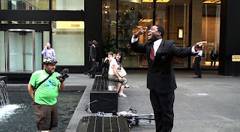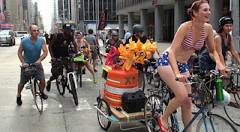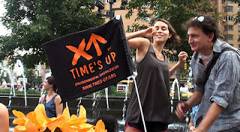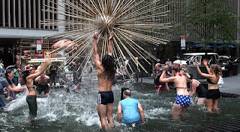"New York Fun Exchange”
Reflections on a Ludic Occupation!
By Benjamin Shepard
From 1998 – 2004, I worked with a public space group called Reclaim the Streets New York. Their first two actions – street parties used to demonstrate alternate uses for public spaces – took place without a hitch in the East Village. Our third action was scheduled to take place on Wall Street June 18, 1999, in coordination with the G8 meetings taking place. The meeting place for the street party was a relatively anonymous bonus plaza known as Zuccotti Park, on Trinity Street and Broadway in Lower Manhattan, a five minute walk from the New York Stock Exchange. When we arrived, we were surrounded by police. As soon as we stepped off the sidewalk into the street, we were arrested. The action lasted only a few minutes.
So when I heard about a call for actions to occupy wall street on September 17 , 2011, Iwondered if those actions would experience a similar fate. And if so, when? After all, what were they planning on doing but creating a space for something new, for a temporary autonomous zone (TAZ) for play? Huizinga, like Marx, saw play as a space outside of labor, a space for ideas, for something beyond the mechanisms of capitalism. This was what seemed to take place with the TAZ which would form in Zuccotti Park, later dubbed Liberty Square, in NYC in September 2011. And this time, the police would not crack down for another two months.
Zuccotti Park and a TAZ at Liberty Square
On September 17 , 2011, a group of activists put out a call to transform the New York Stock Exchange into the “New York Fun Exchange.” The call declared:
Maybe you’ve heard the rumors…September 17…occupy Wall Street…but what is it exactly? Well, it depends on who you ask; but for some of us artists and cultural creators, it means aesthetically taking back one of the most important public spaces in New York City for the people of New York, for all Americans, and for the fun-loving citizens of the world.
How do we do that? Well, take a marketplace that, in a post-9/11 world, has been reduced to a boring tourist zone where no one really feels welcome, and open it up to laughter and excitement by making beautiful music/poetry/performances there! To top it all off, why not invite some real people as well?
On September 17, 2011, we are calling for public artists of all varieties to join us – if you can make it or create it in a public space, then we want you there. We have many activities including spoken word, drum circles, performance pieces, and participatory art planned so far, but all are welcome.
We’re calling it the New York FUN Exchange! (I almost wish we could call it a “Why Can’t Wall Street (come out and) Play? Fair” but maybe I’m just obsessed with double entendres.) We shall let our glee resound from wall to wall to wall…of the Exchange!
All hands are welcome!
That day the group hosted a makeshift festival which evolved into a two- month occupation of a privately owned public space in Lower Manhattan. In the weeks afterward, the fun exchange would expand throughout the city and country. Over the next six months, their topsy-turv y carnival did everything it could to replace mechanisms of capitalism with an ethos of generativity and conviviality. The occupation marked an opening salvo to a campaign to challenge the inequality- generating mechanisms of global capitalism and Wall Street. Occupy Wall Street (OWS) connected multiple streams of an organizing ethos known as "Occupy Everything,” which had been popping up over the previous decade. Through these occupations, public space was reimagined in action as a place for performance, storytelling and communicating to a broad range of corporate targets. Elements of creativity, play, righteous anger, grassroots democracy, direct action combined with a healthy dose of experimentation, community building and peer based popular education to fuel this new movement. Weissman (1990) describes such work as ‘serious play.’ The play is the thing Hamlet used to catch the attention of the king. For the Occupy Movement, the play was the thing used to highlight longstanding critiques of social and economic inequality, as well as calls for more authentic forms of democratic engagement.
The following considers a few of the play- based approaches of the Occupy Wall Street Movement (OWS), in which the author played a role as an observer and participant from its first day on September 17, 2011, through subsequent assemblies, rallies, riots, evictions, and pop-up occupations . It considers five play- based pranks used by OWS, including a bike ride/ pool party in which activists swam in fountains in privately owned public spaces throughout Manhattan, as well as a mobile street party in which activists engaged “OWS” supporters to “decompress” relax and recharge. A third case involved activists dressed as trees moving to Wall Street for a blockade. The performance invoked the twist ending of Shakespeare’s Macbeth when the seemingly impossible prophecy–“when a forest comes to the castle Macbeth would be undone” – was fulfilled. The fourth case study, Occupy Broadway, considers the story of a 24-hour theatrical engagement in a privately owned public space on Broadway in Times Square. Through play and performance, Times Square was once again a place where stories started. Finally, play permeated the build up to the May Day street actions and pickets of 2012. Here play and performance served as intermediaries in a struggle for public space. Play in public space became a means of asserting an alternate form of power in a city dividing itself and its people as class war rages. More than this, a ludic defiance of social mores found its way into multiple street actions along the way. While capitalism seems to rely on sadness to reinforce social obedience to systems of domination, OWS turned to a rambunctious politics of joy, silliness and street antics to break isolation and connect bodies through defiant gestures of creative direct action. Play and street antics brought our bodies into an experience of social connection and freedom.
OWS Decompress
The first weeks of the Occupation of Zuccotti Park in Lower Manhattan were a pulsing period of meetings, clashes with police, and efforts to create a space where new occupiers descended by the day. After some marches tension and tempers rose. A significant percentage of occupiers rarely left Zuccotti Park where the occupation was taking place. Two weeks after the OWS occupation began, New York environmental group Times Up! organized a series of street parties starting at Zuccotti Park, dubbing them the OWS Decompress Rides. The October 6 ride was scheduled to start at 10 p.m., at Zuccotti Park. Times Up ! put out the call inviting OWS participants to join the party. “[A]fter their General Assembly; we'll lead all interested occupiers to dance with us a few blocks away. It's sOOo good to get out of the park for a while, and to dance with the dedicated. Come support and dance in public space!”
Brennan Cavanaugh recalled the genesis of the Rides. “The Decompress OWS Dance Party was a chance for us to take what we call our sound bike with Times Up!, which is basically about an eighty pound sound system, powered by a deep- charged marine battery that we put on our bike cart and we drive around town. So we discovered that this might be appreciated down at Occupy one night when we went down. This is when Times Up! took the sound bike up to the UN to support the Fuku shima mothers, Japanese women who were appealing to the UN to make stronger anti-nuclear laws. So we went up there. And then we decided to go down to Occupy to see what was going on. We had the sound bike with us so we rode around the square three times, dragging the sound bike, blasting Patti Smith’s ‘People Have the Power.’ And this is before they had all the barricades up around the park. And you could come and go easily. There were still no walls. And people just started running out. And running along side us pumping their fists in the air. And it was beautiful. And we realized this could actually be of service. So we would go down there. We would go down the next week.”
The next week, we put out a call for the OWS Decompress ride.
I was supposed to ride up to ABC No Rio, the Lower East Side Squat where Times Up! meets, to bring the sound bike to Zuccotti, but got stuck in the park talking when I first arrived. For those who had spent any time at the Occupation, this was part of the process. One friend I know dropped down for lunch the previous Monday to make some signs. But between meeting a new lover, making art, eating free pizza, rallying, and talking, he didn’t end up leaving for another three days.
The cyclists riding the sound bike from the Lower East Side asked that I notify people we were coming. So I walked through the park telling people. And someone suggested I use the “people’s mike.”
“I can’t. I’ve never done this,” I thought to myself. But the next words coming out of my mouth were:
“Mic check!”
“Mic check” the crowd replied. And I made my announcement. A few people clapped; some didn’t believe I was serious or turned back to their conversations, and others joined. And I announced the ride. Emma Goldman’s "If I Can’t Dance” sentiment could certainly be found here, so wa s the impulse to dance. As I finished, the cyclists arrived. “We rode around the park a couple of times,” recalled Cavanaugh. “And as people came, people said, ‘Go get your friends. We’re going to have a dance party.’ "
Many roared and clapped hands as a bike arrived playing the Clash's “Know Your Rights” on the back of the amplified sound system on wheels. The ride circled the park until it finally stopped on the Southwest Corner.
“And we had a dance party just right on the sidewalk, just across from the park,” recalled Cavanaugh. “And you see some of the people who have been there since day one. And you know them because of their faces and having conversations with them and you think, ‘This is terrific. We’ve just created a release.’ And that’s how the dance party started. The police, some white shirts came, and we just moved down the block. And we just happened to find another public space, that little triangle at Trinity right across from the Blarney Stone.
“All day, all week, occupy the beats!!!” a young man chanted, followed by more claps. For the next hour, we shook it to Jay Z, New Order, James Brown, Public Enemy, and so much more. It was not until past 1 a.m. that the dancing slowed and we meandered back inside the pub. A friend had just come back from Europe. “When we saw the pictures of 700 arrested on the Brooklyn Bridge (the previous Sunday), we knew we had to come home,” explained Monica Hunken, who joined the ride after cutting short a six month trip abroad. The whole world really is watching. Having been part of the riots and street theatrics in Greece this scene felt familiar for her. And we talked and talked and talked until 3 a.m.
"You guys are sure stimulating the blue collar downtown economy," noted the bartender. The vendors are pulsing with business well into the night. And people are making connections across cultures and generations. Even Mayor Bloomberg acknowledged the activists have a point about economic inequality. At the time, it felt like no one was going anywhere. None of us knew where it was going. Yet it helped invite everyone into an impulse to play.
Occupy Fountains Ride
Throughout the fall occupation, city officials and organizers clashed over the very public nature of the Occupy movement and its efforts to reclaim public space from the privatizers ever-ready to privatize profit and socialize losses. Those, such as Brookfield Properties, which received significant zoning concessions to create the publically-owned private space (POPS) known as Zuccotti Parked rack ed their brains about ways to do away with those who had come to make sure the park was zoned for 24-hour access. According to city zoning, these POPS are open to the public for multiple uses. Many reveled in the public nature of Zu ccotti Park, the home of this protest, zoned for 24- hour access. Members of Times Up! had been romping through similar spaces throughout the city for years prior, highlighting that one obvious use for a public fountain is swimming: assembling in a public space, using it to its fullest, and having fun.
So on the sunny Monday of October 10, the group organized one of our fountain rides aimed at reclaiming the POPS. After meeting in Herald Square we rode up Sixth Avenue past Rockefeller Center to dance and swim in the other bonus plazas all over NYC. With “Start Me Up” blaring from the sound bike, we dove into one fountain after another along Sixth Ave, turning the city into a space for play, swimming, and relatedness. Security guard after security guard ran out to ask us to leave, but few could do more than watch. “Get out of the pool,” one implored. “Join us” we screamed back before joining hands and prancing around the fountain. A giddiness pervaded the Indian Summer afternoon.
The POPS are supposed to be accessible to the public. It comes down to a question of accessibility. As William Whyte noted, it is crucial to define what "accessible" means. A commonsense interpretation would say that the public can use these spaces in the same way it uses any public spaces, with the same freedoms and the same constraints. The private owners of these public parks have no right to regulate how they are used, yet they do so with impunity. They hire private security guards to shoo away skaters, nappers, and in this case, swimmers. They only get away with this because nobody has challenged them. A stiff, clarifying test is in order. The Time's Up! fountain rides serve as this sort of test. We have occupied these public spaces, security guards have tried to shoo us away, but no one has been arrested. If anyone is arrested, we will fight the case and prove the legality of our actions, and until then, we will continue to enjoy these spaces and show the public that they can use them just like any other public space. So for a day, we swam freely at most parks. Children jumped in to join us and onlookers applauded from the sidelines. One tourist said that seeing us in one of these fountains made his whole trip to New York worth while. The power of these public spaces is undeniable, from Zuccotti Park up to the fountains along Sixth Ave.
|
Photo credit Time's Up! Environmental Organization |
 |
Photo credit Time's Up! Environmental Organization |
|
Photo credit Time's Up! Environmental Organization |
|
Photo credit Time's Up! Environmental Organization |
|
Photo Credit: Time's Up! Environmental Organization |
Times Up! volunteer Keegan recalled the ride. "It was during Occupy. That was one of the most beautiful rides. What happened was Monica and Ben were abroad when Occupy started and I was communicating with them about what was going on in Zuccotti and they were just so jealous, like oh man we want to be part of this, and they came back and they were just so r aring to go that they had a meeting with Times Up! They planned an action as fast as possible. It was going to be an Occupy Fountain Ride, cause these fountains are POPS, privately owned public spaces, just like Zuccotti, so we’re bringing even more attention to these spaces. These spaces are supposed to be used for the joyous sorts of things that were happening in Zuccotti Park. So we did a fountain ride. But now the scene was there. It was successful. People were talking about it. Thinking about it. So we had a huge turnout. And then we had an incredibly good time. We danced in all these fountains. We got very little harassment from the police. The private security guards had their usual dialogue with us but they were sort of into it. People were stopping in the streets. One tourist told me seeing us dance in the fountains made her trip to New York. It makes my life in New York too, being able to dance in the fountains with you guys."
Local media ran full accounts of the action. The point, of course, was that throughout the city more and more people were becoming aware of the possibilities of exploiting the zoning laws to their advantage to access once fenced off, isolated public spaces. And play was the perfect means with which to explore and reclaim these spaces.



